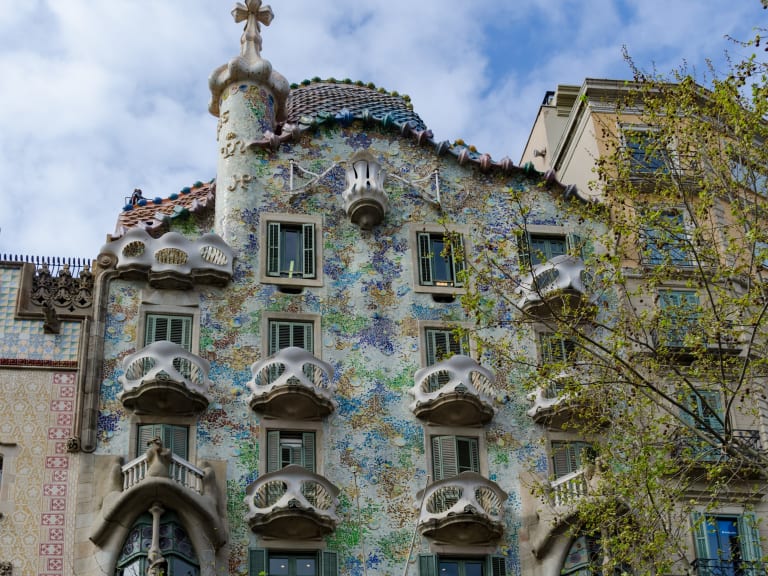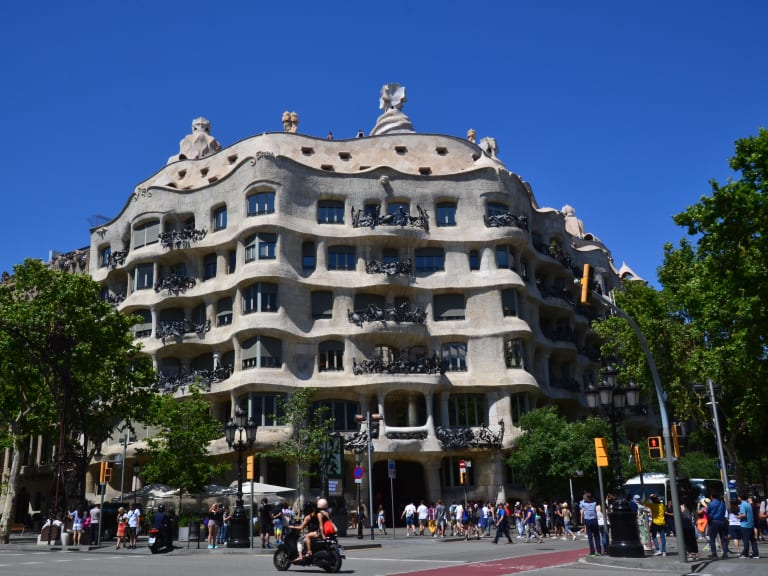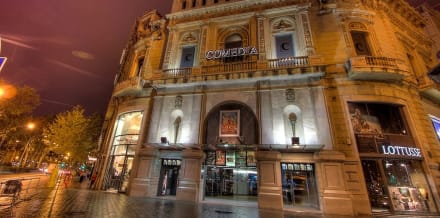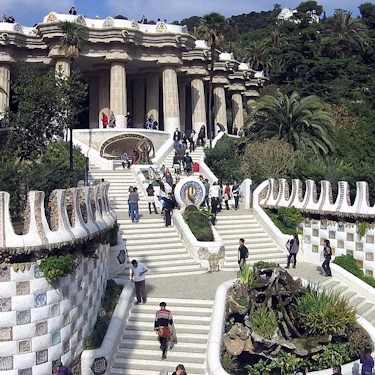More about: Barcelona in 1 Day: a guidebook for getting the most out of your visit
Barcelona is a city that combines history, architecture and modernity. As a result of this mix, Barcelona has a lot to see and offers its visitors countless things to do. Unfortunately, however, we don't always have enough time to make the most of our visit. In many cases we only have 24 hours. And it is precisely for those who only have one day to get to know Barcelona that this little guide is aimed.
Below you will find an itinerary designed to visit most of Barcelona's places of interest in just one day, with an optimal linear route for this purpose. Of course, there are some things that will be left out, but with this approach you will be able to see the essence of Barcelona, its main street, its historic quarter and the modernist part of the city. Without further ado, here are all the details:
The route starts on the Rambla

The first hours of the day and until about midday are reserved for walking along Barcelona's mythical Ramblas and the Gothic Quarter.
Our starting point will be the monument to Columbus located just at the end of the Rambla next to the port. From there we will start walking up the Rambla and we will see the following points of interest:
Plaza Real

Starting to walk along the Rambla from the Christopher Columbus statue, our first stop is the Plaza Real, located on the right hand side from our starting point. This is one of the most important squares in the city and one of its most common meeting points.
Decorated with numerous palm trees and fountains, it is surrounded by bars and cafés where we can sit down and enjoy a good breakfast to get our strength back for the day.
This square was designed by the architect Daniel Molina and was built on the site of the Capuchin convent of Santa Madrona, which was demolished in 1835. It is an access point to the Gothic quarter, although we are not going to enter it yet, and its decoration includes elements such as the lampposts designed by Gaudi and the fountain of the three graces by Antoine Durenne.
Liceu Theatre

Leaving the Plaça Real from the same place where we entered and almost opposite is the historic Liceu theatre. This is the oldest and best known theatre in Barcelona and one of the most prestigious opera houses in the world. From the Rambla we can stop to see its historic façade, although its greatest charm lies inside.
Although the building has suffered numerous accidents such as bombings and two fires, it has kept its charm intact. The last of these fires in 1994 gave way to a reconstruction that was completed in 1999.
With just enough time we can't afford to visit its interior, but make a note of it as a must for when you visit Barcelona with more time.
Boqueria Market

The second obligatory stop on Barcelona's Rambla is the Boqueria market. It is a temple for food lovers.
Inside there are more than 300 stalls with all kinds of top-quality products. Fish, meat, fruit, vegetables... It's well worth going inside and taking a brief stroll around some of them.
If you do, you are sure to get hungry, but you can satisfy your hunger with a quick snack at any of the stalls. Fresh fruit juices are very typical and popular, especially in summer. It is best to visit the Boqueria first thing in the morning, as this is when there are the fewest tourists and when all the produce has just been sold.
Gothic Quarter of Barcelona

Now it's time to enter Barcelona's Gothic Quarter. In contrast to the wide streets and avenues of the rest of the city, this historic quarter of Barcelona is made up of narrow streets and alleys with lots of charm and numerous places of interest.
The best thing to do is to wander through the streets until you reach the Plaça del Pi, where you will find the basilica of Santa Maria del Pi. This church has spectacular stained glass windows and the largest rose window in Catalonia. If the visit coincides with the weekend, it is likely that in the same square you will come across its traditional street markets.
We then move on to the Plaça de Sant Jaume which is the political centre of Barcelona and Catalonia as this square is where the City Hall and the Palace of the Generalitat are located opposite each other.
The most representative place in the neighbourhood is undoubtedly the Cathedral of Barcelona. The impressive building was built from the 13th century until the end of the 20th century, which resulted in a mixture of styles that make it an architectural jewel. But without a doubt the Catalan Gothic style stands out, being the cathedral one of its greatest exponents.
To finish the tour of the Gothic quarter, at the back of the cathedral is the Plaza del Rey, which houses several Gothic buildings such as the Palacio Real Mayor, which was the home of the kings of Aragon.
Catalonia Square

If we have gone at a normal pace, by midday we will have finished seeing the Rambla and the Gothic Quarter. For lunchtime we can go from the Cathedral to Plaza Catalunya. This is the heart of Barcelona and the central axis as it is right in the middle of the historical centre of the city and the modern part of the Eixample.
In the streets around this large square we can find a place to eat and continue our visit. The square is not the most beautiful in Barcelona, but it is the starting point for some of the most important streets in the city, such as La Rambla and Portal del Angel.
Passeig de Gràcia

After lunch and from Plaça de Catalunya it is time to discover the modernist part of Barcelona. This architectural style is the most characteristic of the city largely due to the figure of Antonio Gaudí, who designed the main monuments of Barcelona, some of which we will see in the afternoon.
From Plaça de Catalunya we start our route along Passeig de Gràcia, which is the equivalent of the Champs Elysées in Paris or Fifth Avenue in New York, and where our first two stops of the afternoon are located.
Batlló House

Leaving Plaça Catalunya along Passeig de Gràcia and just a 10-minute walk away is Casa Batlló. One of the symbols of Barcelona and one of its most highly valued monuments.
This unique building is the work of Antonio Gaudi, who designed it at the request of Josep Batlló in 1904. Gaudi had total creative freedom to reform the building, turning it into an architectural symbol that stands out for the shapes and colours of its façade and for its functional but original interior.
The visit to the interior of the house lasts 45 minutes but, as with most of Gaudi's monuments, there are usually huge queues to get inside.
If you're determined to enter if you only have one day to see Barcelona, as is the case with this itinerary, it's almost obligatory to get tickets online to avoid the queues. Next to the Casa Batlló there are other modernist houses worth stopping to see, such as the Casa Amatller right next door, but they are overshadowed by Gaudi's work. In fact, this block is known as the block of discord, as all the houses are by great architects who competed for Barcelona's urban planning prizes.
La Pedrera

La Pedrera, also known as Casa Mila, is also the work of Antonio Gaudi and is located on Passeig de Gràcia, just a few blocks from Casa Batlló. It is somewhat more discreet than the Casa Batlló but is equally worthy of being considered one of Gaudi's and Modernisme's finest works. Its façade and undulating forms are inspired by nature and its famous chimneys, its peculiar roof terrace and the original balcony railings stand out.
It is somewhat newer than the Casa Batlló, as Gaudi was commissioned to design it from scratch and began construction in 1906 until 1912. The commission came from the couple Pere Milà and Roser Segimon to live in it and to rent the rest of the flats in which important figures of Catalan society have lived.
Of course, you can also visit the interior of La Pedrera, but as with Casa Batlló, you have to buy tickets online to avoid queues.
Unfortunately if you only have one day to see Barcelona you can only choose one if you want to see the rest of modernist Barcelona. There is no one better than the other and here it's up to you to decide based on your tastes.
The Sagrada Familia

For the penultimate stop, what better than to visit the symbol of Barcelona par excellence. Gaudi's Sagrada Familia. The temple, although unfinished, is Gaudi's masterpiece and considered to be the greatest exponent of modernism. Construction began in 1882 and it is still not known when it will be finished as it is financed by donations and depends on them.
Yourfirst impression of the building will take your breath away. Its towers dominate the Barcelona skyline although only 8 of the 18 towers Gaudi designed in honour of the twelve apostles, the four evangelists and Jesus and Mary are finished.
The first thing to do is to walk around it to see its three façades. The Nativity façade, dedicated to the birth of Christ, the Passion façade where the same scene of Christ's death is reflected, and the Glory façade which represents death, the Last Judgement, Glory and Hell and is the main façade of the Sagrada Familia. Gaudi himself, who died in an accident in 1926, knowing that he would not see it finished, left sketches of his work for other artists to complete.
If you still have time left over, you can visit the spectacular nature-inspired interior, but again, it is highly recommended that you buy your tickets in advance if you don't want to share a queue with the thousands of tourists who visit it every day.
Park Güell

For the next and last stop on this itinerary, you'll need to take public transport or walk for about 15 minutes. For the first option, you'll have to take metro line 3, the best way to get around Barcelona, to get there in less than 10 minutes. Although it is better to take a short walk from the Sagrada Familia.
In any case, the destination is well worth it, as I am talking about Park Güell. A true demonstration of Antonio Gaudí's ability to create places full of magic. The park began to be built in 1900 and was opened to the public in 1926. To enter you have to buy a ticket but it is definitely worth it.
There is a lot to see inside the park, but since we don't have much time, the highlights we can prioritise are the following: The Plaza de la Naturaleza, the Pórtico de la Bugadera, the Sala Hipóstil, or Hall of the Hundred Columns, the access staircase, the famous lizard that has become a symbol of the park, and to crown the visit the views of Barcelona from the park's viewpoint.
In this link I leave you all the information with the opening hours of the park.
And with Park Güell as a final climax, we finish this tour from Barcelona's Rambla to Gaudi's Barcelona, passing through the Gothic Quarter. The best of Barcelona condensed into a single day. But the city offers much more, so if you have the chance, and you'll want to, come back to visit Barcelona without leaving anything out.




